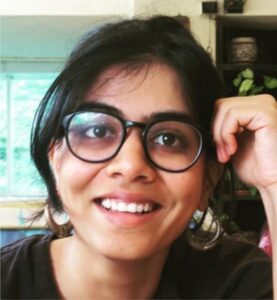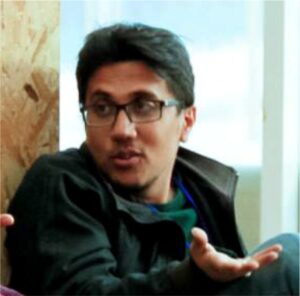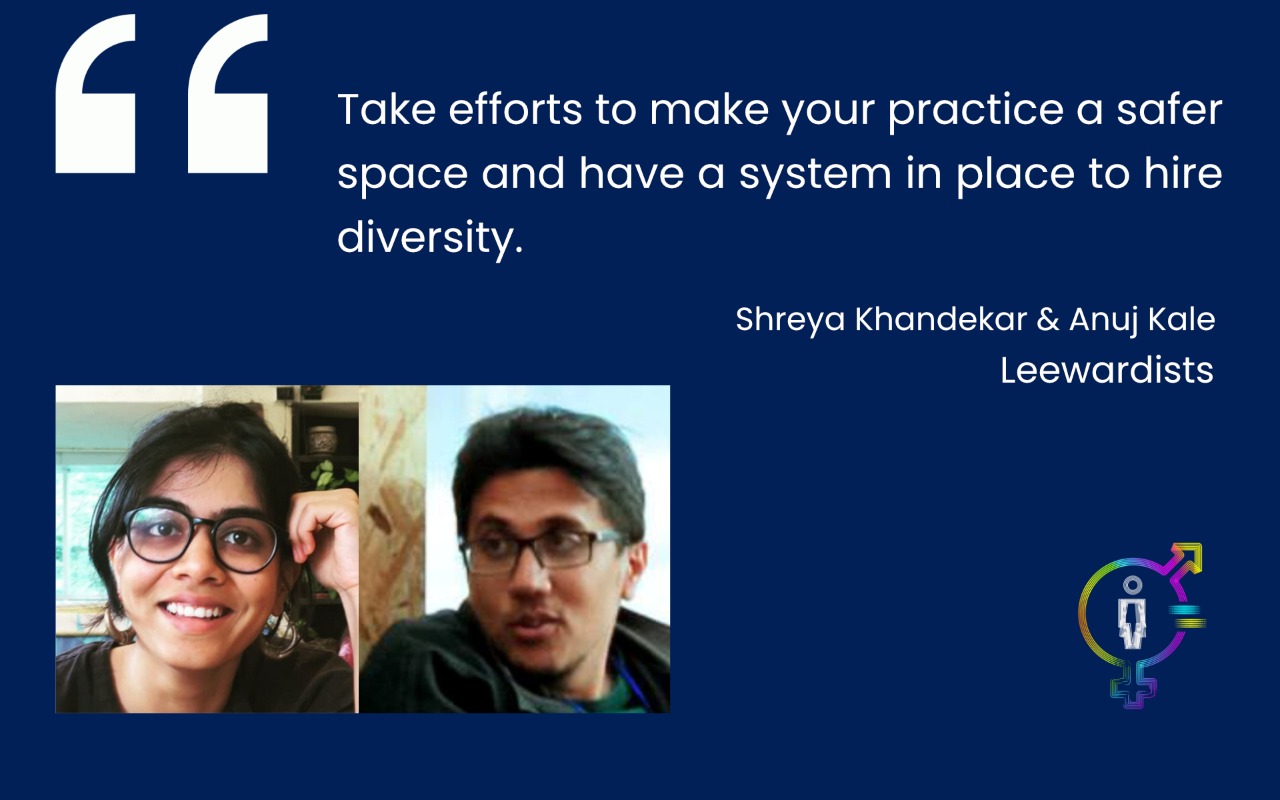Leewardists- If you are an architect with access to social media, chances are that you have come across their comic in some form or the other- their graphic of the droopy-eyed architect is one of the most recognizable representations of architects and architectural students in India.
Leewardists has, through comics and partnered initiatives, over the years, talked about several issues in architecture on education, practice and gender. Thus, it was only natural for us to reach out to Anuj Kale and Shreya Khandekar, partners at Leewardists, to discuss Gender Parity: Architecture Profession in Post-Binary India.
What followed was an intense conversation on Gender Disparity and where the community of architects could start to promote gender inclusion within the Architectural Profession.
Background and Transitioning towards Comics
Shreya (Cishet female) is an architect by training, a comic writer and an artist by profession. She has been a part of Leewardists for six years and is now a partner with the organization.
Anuj (Cishet male) is an architect and urban designer by profession and a storyteller and artist by interest. He is the founder and partner at Leewardists.


While we were still in the middle of introductions, an instance of gender-biased perception had already come along. Shreya, from a small city and a family of non-architects, had one of her early experiences dealing with gender bias in architecture in her architectural school.
Architecture itself was a bold choice, according to some extended family members. But, it was in architectural college when a practising architect infuriated me with a derogatory remark. He told me that Architecture is a safe choice for a girl child since many boys will be happy to marry a woman architect. This was worse than being mocked for taking up a profession other than engineering.
Shreya
In contrast to Shreya’s non-architectural background, Anuj belongs to a family of architects. Looking back at his younger self, he acknowledges his privileged position as a cis-male and credits their initiatives for making him recognize gender-based issues faced by the non-male genders.
I am a man who was negligent about the issues faced by the other genders until recently when Shreya and I started talking about gender and sexuality through comics. In India, the gender disparity is so subtly there and evident through the years that for the 21-year-old Anuj, it would have been difficult to look between the lines and identify that there is a problem. It is so common and natural that most men do not notice the wrong in it.
Anuj
Regardless of their gender, transitioning towards comics was met with some resistance for both.
Making comics after architecture is absurd for anyone. It was difficult for my parents to fathom that I would do something so drastic after five years of architecture- given their non-architectural background, they also failed to understand how this would work financially. The idea of Leewardists is sometimes difficult to explain to fellow architects and peers, let alone to someone from a different generation who has never worked in such a field. However, it was something that branched out from my interest in the built environment and in animations and comics as a child. This was an interesting genre that was not a complete departure from architecture.
Shreya
For Anuj, his experience showed hints of gender discrimination.
People around me made me feel that doing something related to Art/ comics doesn’t sound too manly for society. They said that such a profession because it will not give you money, is eventually taken up by women as a side hobby – which is even worse because when did jobs start to be defined by gender?
Anuj
Gender Discrimination in Architecture: A myth?
At this point, we have had several conversations centred on acceptance, denial and obliviousness towards Gender Disparity with various architects. So, it seemed fair to ask Shreya and Anuj if they witnessed gender discrimination, first or second-hand, in their professional journey.
Shreya considers herself privileged to have worked with professionals who did not gender discriminate. She narrates instances of her female friends being denied a promotion due to pregnancy, the refusal of on-site workers to listen to a female architect over her male counterpart and females being passed over for a job or role because of their gender.
Men dominate the positions of power- the systems in place often deny representation of another gender. Many argue that it is offering positions based on an individual’s experience. But then, if you do not give a chance to another gender in the first place, how would you know if they are capable of that position or not?
Shreya
[gravityform id=”17″ title=”true”]
Agreeing with Shreya on cishet men being in positions of power and having the final say in most professions, Anuj, also a teaching professional, points out gender discrimination observed at the academic level.
In the education realm, as per my observation, despite both male and female teachers, the role different genders possessed were stereotyped! A female teacher would be given managerial jobs, and a young female teacher would be given an assistant job; The harsh critic job would automatically go to a ‘male faculty’ who would conduct a class and give the final ruling. This is subtly done and hence is not made very obvious.
Anuj
Narrating another incident, Shreya points out the lack of gender sensitivity amongst practising professionals within the profession.
A friend of mine was working with an architect who believed in working on-site. But the site did not have clean washrooms and hygienic amenities- making it tough for women on their period. The architect’s solution to the problem was to consider leaving. A sensitive situation like this itself rules out the inclusion of other genders. It is time that we talk about these important issues related to inclusivity rather than ignoring them.
Shreya
First-hand experiences
Shreya: I can never forget this incident. Once in our design studio in school, this misogynist professor asked boys and girls to form two separate groups. He then said that women will get married right after they leave college, while men will have to work hard to provide. Further, he said that men should work harder in a design studio and women can chill and have fun. Some of us couldn’t handle it and called him right there, but he just laughed it off and asked us to get back to work. This was so disturbing as a young student. As a class, I was happy that we shared similar thoughts on how he was so wrong. It felt good to discuss it openly with our male colleagues as well. But, openly saying something like this might empower some young minds in the wrong way. These same students then would run architecture firms or become academicians carrying forward the same ugly thought and, worse, even practice it!
Anuj: When I was teaching, I saw some of my fellow women colleagues being given menial and managerial jobs. They were told that that is what they are best fit for. This kind of discrimination takes away the very reason one has taken the job in the first place.
Promoting Gender Sensitivity through Leewardists
Such instances got translated into comics, leading to a wider audience getting to know about subliminal gender discrimination. Instances that not just dealt with the Architectural Profession but with Architecture. Shreya’s experiences as a user- her hesitancy to travel alone post sunset, being overtly cautious around men and her inability to find clean toilets, prompted Leewardists comics on Gender and City.
If you think about it, these experiences have a lot to do with how our cities are designed. So, comics became the perfect tool to depict how I experience the city– and then move on to collaborate with more like-minded organisations who want to talk about these issues and create a dialogue about what can be done, to make this better or raise questions.
Shreya
Being a cishet male, coming from a privileged background, and not being made aware of these issues, I was unaware till my master’s during which I met professors and colleagues from varied backgrounds, introducing me to these issues. Through Leewardists, we felt a sense of responsibility to talk about them. And when Shreya joined the organization, we talked about these topics more openly. It started at a very personal level- with comics centred on her experiences.
Anuj
Leewardists first gender-based comic, ‘Women in Architecture’ was in association with Ar Amritha Ballal.
This was followed by a gamified idea of inclusivity in cities in collaboration with NIUA, comics based on Shreya’s experience and their recent collaboration with Ar Swati Janu for ‘City for All’.
It was through the City for All collaboration with Ar. Swati Janu, we got to meet people and talk about real issues that different genders and communities face in the city. I have never worked with an LGBTQIA+ colleague, student, or Architect. But we had a great opportunity to work with the LGBTQIA+ community through this project and were deeply sensitized by their experiences. Not only did I learn what it meant to be inclusive in a social setting but felt good having conversations that made a difference.
Anuj
Talking about working with people identifying with genders outside of cisgenders, Shreya adds
I have friends who identify as non-binary, and the only way I could have been better at communicating with them is by making an effort to understand if I have ever been insensitive and working on those. It isn’t as difficult as walking on eggshells around someone. It is about being aware that you treat everyone with the respect they deserve by not being offensive and inappropriate.
Shreya
While Leewardists is actively promoting gender inclusivity within the profession, they believe a lot remains to be done at the professional’s end.
Adopting gender inclusivity in a workspace takes effort and empathy towards the other gender – which takes time, so the easy way out is usually ignoring it.
Shreya
I feel very few people in a position of power think about this, often out of fear that people might call them out for not leading an inclusive practice. But, when making a workspace inclusive, one will have to take tough decisions– which might include changing and redefining existing systems, leading to them not having the final say. And so either they will ignore this idea completely or fix a few things that look good on the façade but don’t solve the issue- for instance, at the architecture conferences. In the name of ‘inclusivity,’ they call a token woman architect (forget someone from the LGBTQIA+ community), and if someone points out, they call it an inclusive panel! So, to solve this issue, people will have to accept that they are in the wrong, which is very difficult. Almost impossible!
Anuj
Similarly, at the Academic level, Anuj believes the decision-makers seldom take responsibility, and if they do– it is under pressure or due to someone’s inappropriate behaviour that forced them to look into the matter.
Awareness or Unawareness?
The Architectural Profession seems to be dominated by people coming from privileged positions with regard to their gender. This has contributed towards a significant number of people being ignorant of gender-related issues.
Because our profession is so unorganised and with no real systems in place regarding gender inclusivity in workspaces, it is much easier for architects to ignore it.
Shreya
Leewardists has been working towards tackling this ignorance, often with help from their followers.
Many of our followers have trusted us with their personal experiences to make more people aware of what is wrong with the profession. This helps us to amplify and make more people aware.
Shreya
We are trying to, at least, create a discourse and encourage people to discuss and debate. Through Leewardists, we often portray situations as small narratives – not just sexist behaviour but inappropriate situations that we face in workplaces and schools.
Anuj
They credit social media for giving them the platform to hold necessary conversations and discussions on real issues.
I think it (social media) helps different people in different ways. Many of our followers tell us that they have experienced something similar, and the comic helped them discuss it more freely. Then some realized that they saw someone experience similar problems in a workspace, and the comic helped them identify and eventually call it out.
Anuj and Shreya
Message to the Community of Architects
As young architects, Anuj and Shreya have been actively calling out the gender disparity within the profession. They consider India’s young architects to be more aware, sensitive, and intolerant towards these issues and could give rise to a profession that is more empathetic and inclusive.
To our senior architects, they suggest,
Listen to the young architects, we make sense, more times than you think.
Shreya
If you want to make our industry more inclusive, you have to start taking accountability for your actions and actively participate in discussions with a diverse group and not just people your age!
Anuj
Practising Gender Inclusivity
We asked Anuj and Shreya to break down the contribution each member of the community could make to lead to a gender-inclusive profession.
For Students
Shreya: Take more effort to understand how to design inclusively, as that is the way a good design should be approached.
Anuj: This comes from a personal experience from my under-grad school- some schools ask students to sit according to their gender. So, if this is a situation at your school, sit irrespective of your gender and try to socialize and mingle.
For Practising Architects
Anuj and Shreya: Take efforts to make your practice a safer space and have a system in place to hire diversity.
For Academicians
Shreya: Make it a default setting to talk about inclusive designs no matter which year or what type of studio it is. Also, allow students to question if anything is wrong with existing theories and concepts that we learn and how they can be re-defined.
Anuj: Take some accountability in your actions as you are also responsible to shape young students.
Also, we all have been part of casual sexist conversations mainly because our education doesn’t address sensitization- be open to accepting that you did not know any better and then unlearn and re-learn things. That is the only way to move forward and be a better professional, friend, or co-worker.
Shreya
For Authorities
Anuj and Shreya: Decision-making groups need to be more diverse so that we can truly make inclusive cities.
For Clients
Shreya: You should not say ‘woman’ architect and architect (for males). It is very disrespectful.
Anuj: And don’t stereotype a gender to a certain kind of practice.
And lastly, to our contractors and non-architect colleagues, they say
Listen to the professional regardless of their gender.
– Anuj and Shreya







